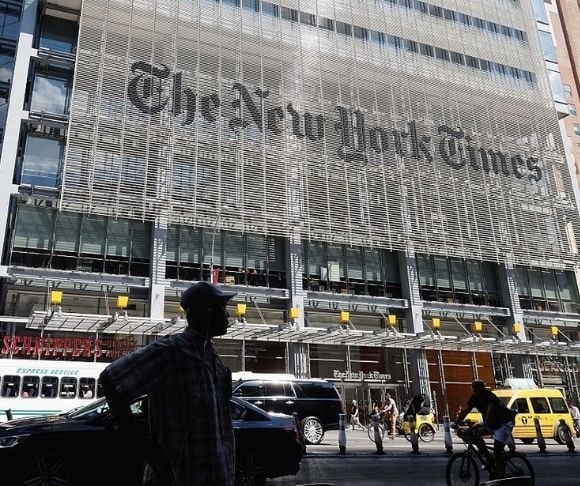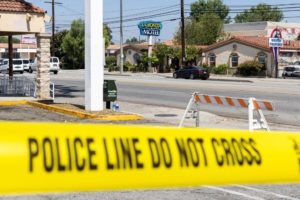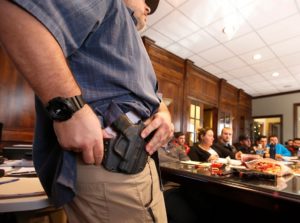
(Photo by Mike Coppola/Getty Images)
The case against the private ownership of firearms is weak, riddled with contradiction, supported largely by selectively edited statistics, and heavily reliant upon hollow emotional pleas that ignore real-world outcomes. Not to mention the fact that its intended goal is entirely unconstitutional. Still, kudos to The New York Times for trying to develop an untrodden path of attack on the Second Amendment. That’s about as much praise as the newspaper deserves, however, because its June 22 article “Who Stops a ‘Bad Guy With a Gun’?” – apart from omitting a couple of significant points that unravel its entire premise – was authored by two people who, while no doubt being near the pinnacle of their profession, could hardly be less qualified to weigh in on gun rights. If this article doesn’t persuade Americans to give up their firearms, the guy or gal running the NYT printing press will be next to hit the keyboard. It’s a real media gun control Hail Mary: Unleash the graphic designers!
 Gun rights advocates frequently claim that when the rubber meets the road, a good guy with a gun is the last, and surest, line of defense against a bad guy with a gun. It really isn’t easy to dispute this fact. After all, it is precisely why would-be mass shooters invariably target facilities or public spaces they assume are likely to be devoid of armed civilians and probably have only unarmed security, if any at all. It is why mass shootings at police stations, gun stores, gun shows, and shooting ranges are about as common as white rhinos.
Gun rights advocates frequently claim that when the rubber meets the road, a good guy with a gun is the last, and surest, line of defense against a bad guy with a gun. It really isn’t easy to dispute this fact. After all, it is precisely why would-be mass shooters invariably target facilities or public spaces they assume are likely to be devoid of armed civilians and probably have only unarmed security, if any at all. It is why mass shootings at police stations, gun stores, gun shows, and shooting ranges are about as common as white rhinos.
A Picture Leaves Out a Thousand Words
The Times article was based around a very pretty and, it must be conceded, very effective graphic that shows how only a small percentage of active shooter incidents are stopped by the much-talked-about good guy with a gun – meaning an armed civilian.
The illustration shows the outcome of 433 active shooter attacks; 249 that ended before police arrived at the scene and 184 that ended after police got there. The first thing to note, then, is that the presence of law enforcement was a factor in less than half (42.49%) of the attacks, which dispels the myth that civilians do not need guns for protection because the police will keep them safe. The police response to the recent school shooting in Uvalde, Texas – described by the director of the Texas Department of Public Safety as an “abject failure” – further illustrates, in the starkest terms, why civilians cannot depend upon police officers to protect them.

(Photo by Qian Weizhong/VCG via Getty Images)
According to the chart, of the 249 incidents that ended before police showed up, the shooter committed suicide or fled the scene in 185 cases. The remaining 64 attacks were ended by civilians or off-duty police officers. On 42 occasions, the shooter was subdued by would-be victims or bystanders (though the article does not say whether any of those instances involved a civilian “subduing” the attacker by presenting a firearm). In the remaining 22 cases, the gunman was shot – by an armed civilian, more than half of the time.
The article concludes, then, that the good guy with a gun is largely mythical. But, wait a minute, wasn’t the mass shooting brought to an end, on 12 occasions, by an armed civilian? How many lives were potentially saved by those 12 interventions? Are they to be discounted while gun-control advocates constantly proclaim, “if we save even one life”? Moreover, armed security officers ended the attack in seven instances, but anti-gunners also tend to oppose more armed guards for schools.
If we save even one life – but let’s disarm citizens and resist providing our children with protective officers, even though this beautiful graphic from The New York Times shows that doing so will cost lives.
Good Guys with Guns Doing Pretty Well
The article also points out, “Bystanders stop some attackers, more often with physical force than with a gun.” But there is a glaringly obvious explanation for this that is missed by the graphic designer gun experts; only a tiny percentage of civilians carry guns. One can find multiple sources and studies, giving different numbers, in the search to determine how many Americans carry in public. Even despite a massive surge in concealed carry permit applications – about a 48% increase between 2016 and 2021, according to the Crime Prevention Research Center – only around 6.5%, at most, of Americans have these permits. That percentage may in fact be significantly lower since it does not account for civilians who may have more than one permit, issued by different states.

(Photo by George Frey/Getty Images)
Additionally, just a small percentage of permit holders carry a firearm in public on a daily basis. A study from the American Public Health Association, published in 2017, estimated that around nine million American adults carried a loaded handgun monthly and about three million did so daily. Just under one percent of Americans, then, go armed in public every day, but civilians with guns still brought an end to 2.77% (12) of the 433 active shooter incidents covered by The New York Times – 4.82% of all the attacks that ended before police arrived. That is a pretty compelling example of the relative effectiveness of armed citizens in halting active shooters. Imagine how many of those potential mass-murderers could have been stopped if twice as many civilians carried guns wherever they go.
Finally, the Gray Lady’s top technical illustrators, for all their supposed expertise in analyzing gun violence statistics, utterly failed to account for the hundreds of thousands of times – according to data gathered by the Centers for Disease Control and Prevention – armed civilians use firearms defensively each year. How many of those actions prevented active shooter events, we simply cannot measure.
When one is faced with the task of eliminating a constitutional and fundamental right by using clearly flawed logic and indeterminate statistics, one must get creative. The New York Times made a valiant effort but ultimately failed. Perhaps next time, the editors over there should give their cafeteria staff a shot.
Remember to check out the web’s best conservative news aggregator
Whatfinger.com — the #1 Alternative to the Drudge

